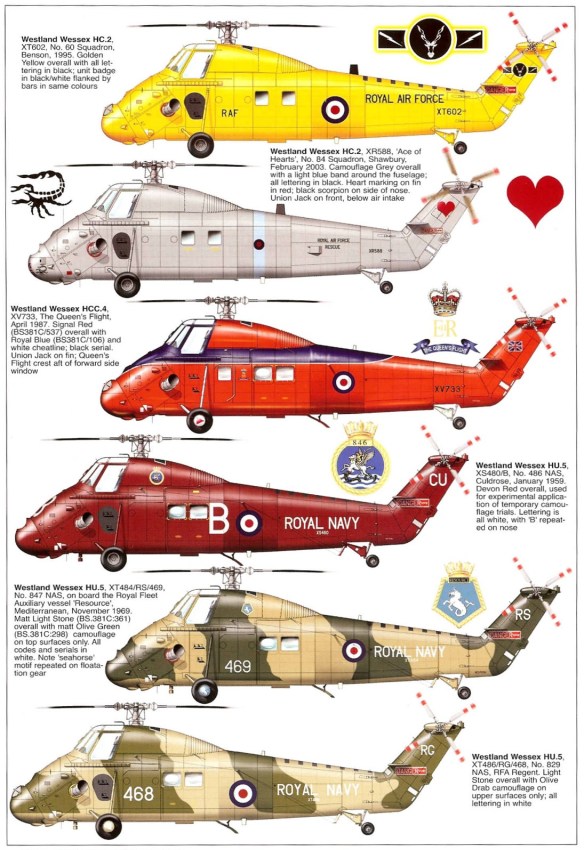In 1956, Westland acquired a license to build the S-58 and developed a turbine-engined version called the Wessex. Initially Westland imported an HSS-1 and flight tested the aircraft with its original Wright engine. The company then modified the machine with a 1,100-horsepower Napier Gazelle gas turbine engine and improved metal rotor blades, designed to sustain more combat damage. On May 17, 1957, the modified rotorcraft made its first flight, and on June 20, 1958, two preproduction Wessex Mk 1s, designed for naval trials, followed. Upgraded with a 1,450-horsepower Gazelle Mk. 161 engine and equipped with a dipping sonar and homing torpedoes, the HAS Mk. 1 went into production in 1959 for the Royal Navy (RN) as an ASW helicopter. RN No. 700H Flight received the first models in April 1960, and the next year six RN squadrons added the new aircraft to their inventory; the first No. 815 Squadron received theirs in July 1961. The RN equipped 848 Squadron with Wessex designed for commando assaults and stationed them aboard HMS Albion. These aircraft carried sixteen fully equipped Royal Marine commandos or eight stretchers and a medical attendant in the cargo area. Optionally, the commando version could deliver a 3,600- pound slingload on an external hook. In January 1967 the HAS Mk. 3 entered service. Powered by a 1,600-horsepower Gazelle Mk 122, Westland installed advanced search gear in a large dorsal radome. In August 1962, Westland began supplying the Royal Australian Navy with a Wessex model similar to the HAS Mk 1 but powered by a 1,540-horsepower Gazelle Mk 162 engine. Westland delivered a total of 320 military variants to UK armed forces and another 42 versions to foreign militaries. The Queen’s Flight detachment received all-red HCC 4s with VIP interiors and advanced avionics.
Countries of origin: USA and UK
Type: Utility transport/SAR helicopter
Powerplants: HC. 2 – Two 1005kW (1350shp) Rolls-Royce (Bristol Siddeley) Gnome Mk 110/111 turboshafts, driving a four bladed main rotor and four bladed tail rotor.
Performance: HC. 2 – Max speed at sea level 212km/h (115kt), max cruising speed 195km/h (105kt).
Max initial rate of climb 1650ft/min.
Hovering ceiling out of ground effect 4000ft.
Ferry range with auxiliary fuel 1040km (560nm).
Range with standard fuel 770km (415nm).
Weights: HC. 2 – Operating empty 3767kg (8304lb), max takeoff 6123kg (13,500lb).
Dimensions: HC. 2 – Main rotor diameter 17.07m (56ft 0in), length overall rotors turning 20.04m (65ft 9in), fuselage length 14.74m (48ft 5in), height overall 4.93m (16ft 2in), height to top of rotor head 4.39m (14ft 5in). Main rotor disc area 228.1m2 (2643.0sq ft).
Accommodation: Two pilots on flight deck with up to 16 equipped troops in main cabin. In medevac configuration can be fitted for eight stretcher patients, two seated patients and a medical attendant.
Armament: None usually.
Operators: UK, Uruguay. History: The Wessex is a re-engined and re-engineered development of Sikorsky’s S-58, developed initially for the Royal Navy as an ASW platform. The Sikorsky S-58 arose from a 1951 US Navy requirement for an ASW helicopter. The Wright R-1820 radial piston engine powered S-58 flew for the first time on March 8 1952 and was adopted by the US Navy as the HSS-1 Seabat (or SH-34G from 1962). Other S-58 variants include the US Army’s CH-34 Choctaw and the US Marine Corp’s UH-34 Seahorse. All piston powered S-58s have now been retired from military service, although small numbers of twin Pratt & Whitney Canada PT6T turboshaft S-58T conversions serve in Thailand and Indonesia. UK interest in the S-58 came about when the Royal Navy cancelled development of the twin Napier Gazelle turboshaft powered Bristol 191 in 1956. The 191 was being developed to meet an ASW helicopter requirement but instead the RN opted for the development of a single Napier powered development of the S-58 to meet its requirement. A Westland re engined Napier powered S-58 flew for the first time on May 17 1957, and the type was ordered into production as the Wessex HAS. 1 (with dunking sonar and armed with torpedoes). Now retired Wessex variants include the HAS. 1, more powerful HAS. 3 with a new automatic flight control system, the Royal Marines’ HU. 1 troop transport and the RAF’s HC. 5, a transport conversion of RN HAS. 1/HAS. 3S. The RAF’s major Wessex variant is the HC. 2, which differs significantly from the Royal Navy’s Wessexes in that it is powered by two Bristol SidJeley Gnome turboshafts joined through a combining gearbox. About 60 HC. 2s still serve with the RAF for search and rescue and utility transport, while HC. 2s exported to Brunei (as the Mk 54), Iran (Mk 52) and Ghana (Mk 53) have all been retired.
